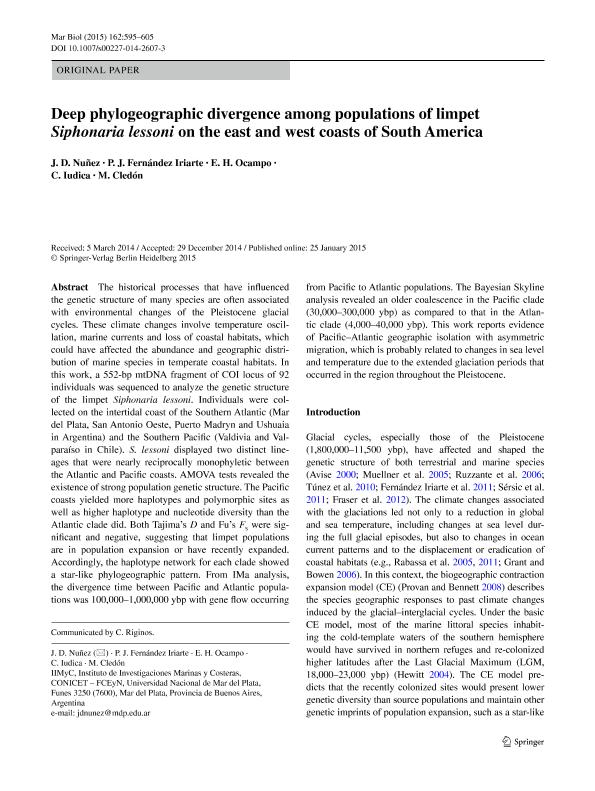Mostrar el registro sencillo del ítem
dc.contributor.author
Nuñez, Jesus Dario

dc.contributor.author
Fernandez Iriarte, Pedro Jose

dc.contributor.author
Ocampo, Emiliano Hernan

dc.contributor.author
Iudica, Celia Estela

dc.contributor.author
Cledón, Maximiliano

dc.date.available
2020-03-25T20:32:15Z
dc.date.issued
2015-01
dc.identifier.citation
Nuñez, Jesus Dario; Fernandez Iriarte, Pedro Jose; Ocampo, Emiliano Hernan; Iudica, Celia Estela; Cledón, Maximiliano; Deep phylogeographic divergence among populations of limpet Siphonaria lessoni on the east and west coasts of South America; Springer; Marine Biology; 162; 3; 1-2015; 595-605
dc.identifier.issn
0025-3162
dc.identifier.uri
http://hdl.handle.net/11336/100791
dc.description.abstract
The historical processes that have influenced the genetic structure of many species are often associated with environmental changes of the Pleistocene glacial cycles. These climate changes involve temperature oscillation, marine currents and loss of coastal habitats, which could have affected the abundance and geographic distribution of marine species in temperate coastal habitats. In this work, a 552-bp mtDNA fragment of COI locus of 92 individuals was sequenced to analyze the genetic structure of the limpet Siphonaria lessoni. Individuals were collected on the intertidal coast of the Southern Atlantic (Mar del Plata, San Antonio Oeste, Puerto Madryn and Ushuaia in Argentina) and the Southern Pacific (Valdivia and Valparaíso in Chile). S. lessoni displayed two distinct lineages that were nearly reciprocally monophyletic between the Atlantic and Pacific coasts. AMOVA tests revealed the existence of strong population genetic structure. The Pacific coasts yielded more haplotypes and polymorphic sites as well as higher haplotype and nucleotide diversity than the Atlantic clade did. Both Tajima’s D and Fu’s Fs were significant and negative, suggesting that limpet populations are in population expansion or have recently expanded. Accordingly, the haplotype network for each clade showed a star-like phylogeographic pattern. From IMa analysis, the divergence time between Pacific and Atlantic populations was 100,000–1,000,000 ybp with gene flow occurring from Pacific to Atlantic populations. The Bayesian Skyline analysis revealed an older coalescence in the Pacific clade (30,000–300,000 ybp) as compared to that in the Atlantic clade (4,000–40,000 ybp). This work reports evidence of Pacific–Atlantic geographic isolation with asymmetric migration, which is probably related to changes in sea level and temperature due to the extended glaciation periods that occurred in the region throughout the Pleistocene.
dc.format
application/pdf
dc.language.iso
eng
dc.publisher
Springer

dc.rights
info:eu-repo/semantics/openAccess
dc.rights.uri
https://creativecommons.org/licenses/by-nc-sa/2.5/ar/
dc.subject
PHYLOGENETIC
dc.subject
LIMPETS
dc.subject
INTERTIDAL
dc.subject
INDIRECT DEVELOP
dc.subject.classification
Biología Marina, Limnología

dc.subject.classification
Ciencias Biológicas

dc.subject.classification
CIENCIAS NATURALES Y EXACTAS

dc.title
Deep phylogeographic divergence among populations of limpet Siphonaria lessoni on the east and west coasts of South America
dc.type
info:eu-repo/semantics/article
dc.type
info:ar-repo/semantics/artículo
dc.type
info:eu-repo/semantics/publishedVersion
dc.date.updated
2020-03-25T13:58:54Z
dc.journal.volume
162
dc.journal.number
3
dc.journal.pagination
595-605
dc.journal.pais
Alemania

dc.journal.ciudad
Berlin
dc.description.fil
Fil: Nuñez, Jesus Dario. Consejo Nacional de Investigaciones Científicas y Técnicas. Centro Científico Tecnológico Conicet - Mar del Plata. Instituto de Investigaciones Marinas y Costeras. Universidad Nacional de Mar del Plata. Facultad de Ciencias Exactas y Naturales. Instituto de Investigaciones Marinas y Costeras; Argentina
dc.description.fil
Fil: Fernandez Iriarte, Pedro Jose. Consejo Nacional de Investigaciones Científicas y Técnicas. Centro Científico Tecnológico Conicet - Mar del Plata. Instituto de Investigaciones Marinas y Costeras. Universidad Nacional de Mar del Plata. Facultad de Ciencias Exactas y Naturales. Instituto de Investigaciones Marinas y Costeras; Argentina
dc.description.fil
Fil: Ocampo, Emiliano Hernan. Consejo Nacional de Investigaciones Científicas y Técnicas. Centro Científico Tecnológico Conicet - Mar del Plata. Instituto de Investigaciones Marinas y Costeras. Universidad Nacional de Mar del Plata. Facultad de Ciencias Exactas y Naturales. Instituto de Investigaciones Marinas y Costeras; Argentina
dc.description.fil
Fil: Iudica, Celia Estela. Consejo Nacional de Investigaciones Científicas y Técnicas. Centro Científico Tecnológico Conicet - Mar del Plata. Instituto de Investigaciones Marinas y Costeras. Universidad Nacional de Mar del Plata. Facultad de Ciencias Exactas y Naturales. Instituto de Investigaciones Marinas y Costeras; Argentina
dc.description.fil
Fil: Cledón, Maximiliano. Consejo Nacional de Investigaciones Científicas y Técnicas. Centro Científico Tecnológico Conicet - Mar del Plata. Instituto de Investigaciones Marinas y Costeras. Universidad Nacional de Mar del Plata. Facultad de Ciencias Exactas y Naturales. Instituto de Investigaciones Marinas y Costeras; Argentina
dc.journal.title
Marine Biology

dc.relation.alternativeid
info:eu-repo/semantics/altIdentifier/url/https://link.springer.com/article/10.1007/s00227-014-2607-3
dc.relation.alternativeid
info:eu-repo/semantics/altIdentifier/doi/http://dx.doi.org/10.1007/s00227-014-2607-3
Archivos asociados
